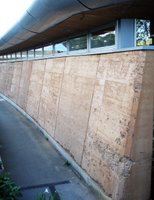
From Wikipedia, the free encyclopedia
Rammed earth construction, also known as pisé de terre or simply pisé, is an old building method that has seen a revival in recent years as people seek low-impact building materials and natural building methods. Traditionally, rammed earth buildings are common in arid regions where wood is in scarce supply.
Walls are constructed from a mixture of earth that has suitable proportions of sand, gravel and clay sometimes with an added stabilizer. Traditional stabilizers such as lime or animal blood were used to stabilise the material, but cement has been the stabilizer of choice for modern times.
Formwork is set up creating the desired shape of the section of wall, damp material is poured in to a depth of between 100 to 250mm (4 to 10 inches). A pneumatically powered backfill tamper - something like a pogo stick with a flat plate on the bottom - is then used to compact the material to around 50% of its original height. Further layers of material are added and the process is repeated until the wall has reached the desired height. The forms can be removed immediately, this is necessary if wire brushing to reveal texture is desired otherwise walls become too hard after around 60 minutes. Exposed walls should then be water sealed.
In modern variations of the method the rammed earth walls are constructed on top of conventional footings and a reinforced concrete base, usually with extra ground insulation from a horizontal layer of styrofoam.
One of the significant benefits of rammed earth constructions is its excellent thermal mass; it heats up slowly during the day and releases its heat during the evening. This can even out daily temperature variations and reduce the need for air conditioning and heating. On the other hand, rammed earth is not a good insulator. Like brick and concrete (which also have excellent thermal mass), rammed earth must be insulated in colder climates. The thickness and density of the walls lends itself naturally to sound proofing and the materials used in the walls make them virtually fireproof.
Prior to the use of cement as a stabilizer, rammed earth buildings were most successful in dry climates with limited availability of building materials other than earth. Rammed earth has become a viable material in wetter climates, either through the use of cement stabilisation, through placing the earth walls within the weatherproof fabric of the building, or by the application of external insulation and weatherproofing.


No comments:
Post a Comment